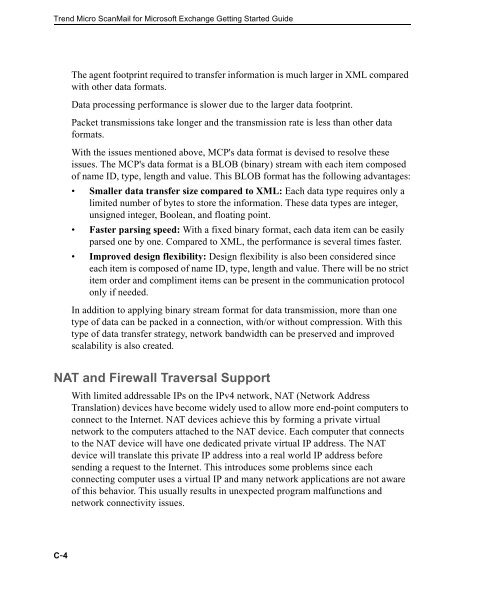Trend Micro ScanMail for Microsoft Exchange Getting Started Guide
Trend Micro ScanMail for Microsoft Exchange Getting Started Guide
Trend Micro ScanMail for Microsoft Exchange Getting Started Guide
You also want an ePaper? Increase the reach of your titles
YUMPU automatically turns print PDFs into web optimized ePapers that Google loves.
<strong>Trend</strong> <strong>Micro</strong> <strong>ScanMail</strong> <strong>for</strong> <strong>Micro</strong>soft <strong>Exchange</strong> <strong>Getting</strong> <strong>Started</strong> <strong>Guide</strong><br />
C-4<br />
The agent footprint required to transfer in<strong>for</strong>mation is much larger in XML compared<br />
with other data <strong>for</strong>mats.<br />
Data processing per<strong>for</strong>mance is slower due to the larger data footprint.<br />
Packet transmissions take longer and the transmission rate is less than other data<br />
<strong>for</strong>mats.<br />
With the issues mentioned above, MCP's data <strong>for</strong>mat is devised to resolve these<br />
issues. The MCP's data <strong>for</strong>mat is a BLOB (binary) stream with each item composed<br />
of name ID, type, length and value. This BLOB <strong>for</strong>mat has the following advantages:<br />
Smaller data transfer size compared to XML: Each data type requires only a<br />
limited number of bytes to store the in<strong>for</strong>mation. These data types are integer,<br />
unsigned integer, Boolean, and floating point.<br />
Faster parsing speed: With a fixed binary <strong>for</strong>mat, each data item can be easily<br />
parsed one by one. Compared to XML, the per<strong>for</strong>mance is several times faster.<br />
Improved design flexibility: Design flexibility is also been considered since<br />
each item is composed of name ID, type, length and value. There will be no strict<br />
item order and compliment items can be present in the communication protocol<br />
only if needed.<br />
In addition to applying binary stream <strong>for</strong>mat <strong>for</strong> data transmission, more than one<br />
type of data can be packed in a connection, with/or without compression. With this<br />
type of data transfer strategy, network bandwidth can be preserved and improved<br />
scalability is also created.<br />
NAT and Firewall Traversal Support<br />
With limited addressable IPs on the IPv4 network, NAT (Network Address<br />
Translation) devices have become widely used to allow more end-point computers to<br />
connect to the Internet. NAT devices achieve this by <strong>for</strong>ming a private virtual<br />
network to the computers attached to the NAT device. Each computer that connects<br />
to the NAT device will have one dedicated private virtual IP address. The NAT<br />
device will translate this private IP address into a real world IP address be<strong>for</strong>e<br />
sending a request to the Internet. This introduces some problems since each<br />
connecting computer uses a virtual IP and many network applications are not aware<br />
of this behavior. This usually results in unexpected program malfunctions and<br />
network connectivity issues.
















